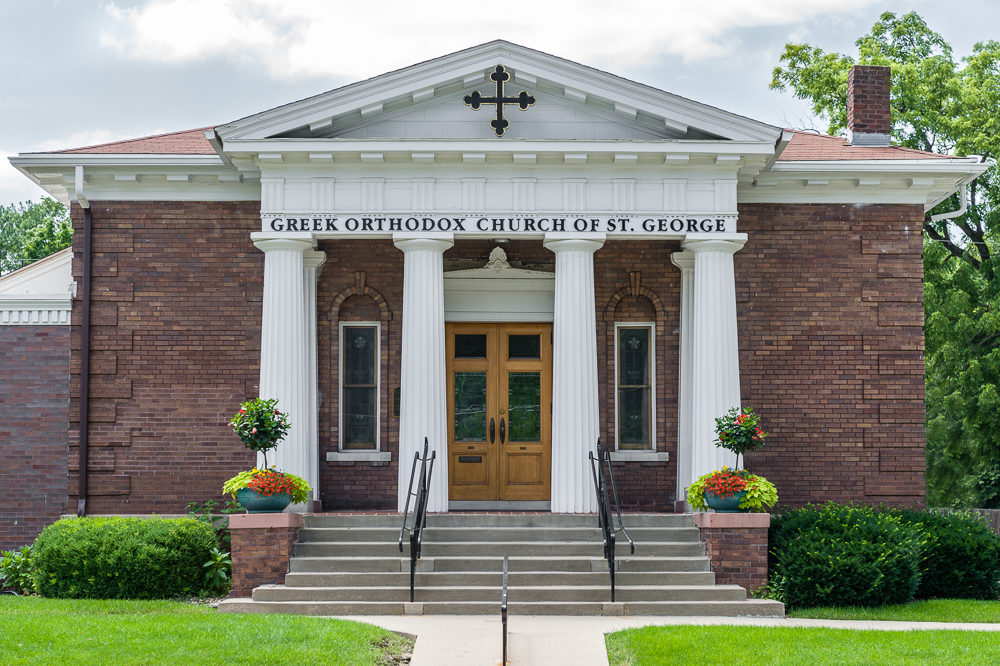Although its altar faces the wrong direction, St. George’s Greek Orthodox Church is orthodox through and through. It didn’t begin that way—the building was originally constructed in 1906 as Elmwood Presbyterian Church. But shortly after the Presbyterians moved out, a local Greek parish moved in, holding its first worship service on Christmas of 1930. At first, the congregation wondered what to do about the problem of the altar, which faced west, not east (toward the rising sun), as orthodox altars traditionally do. Eventually, it was decided that it was just too impractical to reorient the sanctuary—the altar would remain facing west.
The altar tells of Orthodox Christianity in general. On the one hand, Orthodox Christians regard their faith as the oldest and most original form of Christianity. They adhere to all seven of the Ecumenical Councils that defined Christian doctrine regarding the Trinity and Jesus Christ. And they preserve the original ecclesiastical structure of the Church, for which each city had a bishop and all bishops were equal. But on the other hand, even the Orthodox Church has had to make accommodations to modern realities and exigencies, especially in America. St. George’s altar is one example. Another is its pews, which are absent from traditional Orthodox churches. But the most striking is the language of the liturgy, which is now conducted partly in English, no longer entirely in the koine Greek of the early Church.
Despite the fact that its altar faces west and its nave includes pews, St. George’s itself is unmistakably Orthodox. Some of its character predates the congregation, which inherited a building that already included Doric columns on its outside and a domed ceiling on its inside. But most of the architectural features that commonly define an Orthodox Church were installed as the congregation moved in: icons of Jesus, Mary, and the many saints of the Christian Church; an icon of the patron saint of the church, St. George the dragon-slayer; an icon screen (iconostasis) to separate the altar of the church from its nave; and the altar area itself, where the holy sacraments are prepared for Eucharist.
Not only does the church look Orthodox; its daily liturgy is Orthodox, employing a form that stretches back to the fourth-fifth-century archbishop of Constantinople, St. John Chrysostom—this is a form that inspires all the senses: the sights of the Lesser Procession of the Gospel and the Greater Procession of the Sacraments; the sounds of the singing of the hymns and the chanting of the Creed; the smell of the incense censed by the priest; the touch of one’s head and chest with the sign of the cross, the first three fingers joined to symbolize the Trinity, the last two fingers curled to represent the divine and human natures of Jesus Christ; and the taste of the bread and wine, mystically transformed into the body and blood of Christ. This is no Christianity of private beliefs and experiences; it is through bodily participation in the Eucharist that Orthodox Christians are made like God through a process called theosis.
It is a remarkably diverse community that has been and still is made like God at St. George’s. Orthodox Christianity itself includes churches all over the world, most notably in Greece and the Balkans, North Africa and the Middle East, Russia and Eastern Europe. Orthodox Christians from many of these areas have worshipped at St. George’s. Some still do, while others have begun their own churches in Des Moines—Ethiopians and Eritreans, Russians and Serbs, Syrians and Egyptians in particular. Many of these Orthodox Christians gathered at Saint George’s in 1997 for a very special event—a visit by the Ecumenical Patriarch. And in 2005 the church celebrated another important milestone—the appointment of St. George’s first Iowa-born priest. A decade later, Father Basil continues to guide his congregation in the liturgy toward theosis.


